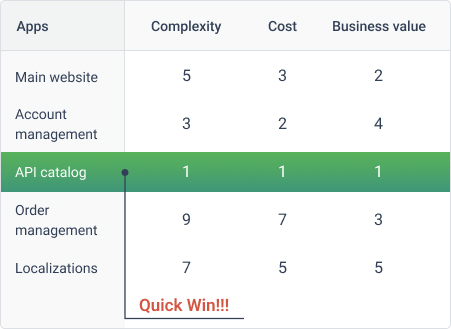Cutting legacy costs may be achieved by removing duplicate software, eliminating payments for infrastructure licenses, offshoring some tasks without sacrificing productivity, and redeploying workforce. However, the key question is there a strategic approach to digital transformation that allows CIOs to reduce costs in the process of app modernization?
Incremental Modernization
Incremental modernization lets you upgrade legacy systems without the pain and risk of a full rewrite. It's ideal when budgets are tight but progress can't wait.
Application modernization can be achieved with less funding or a full system migration to the cloud. Begin with the most critical areas that deliver quick wins, then build on that success.
Even complex on-premises applications can be modernized step by step. Smaller, concentrated changes often deliver faster results with less disruption than large-scale rewrites.
This systematic and fact-based method focuses on modifying organization-critical applications through a series of smaller, well-defined projects that require fewer resources. Each improvement builds on the last, helping your team to recognize value quickly and adapt at its own pace.

The entire application can be modernized using the incremental approach. At the technology stack level each increment adds modernized code which decreases the percentage of legacy code. Eventually, the legacy system will become completely modernized.

Transforming a long-term ambitious legacy modernization project into mini steps with clearly defined goals and outcomes will help show all stakeholders the tangible results from each milestone. It can also help prevent procrastination because small, quick wins stimulate progress and boost morale.
Dmitry Baraishuk Chief Innovation Officer at Belitsoft on Forbes.com

"An iterative light‑weight modernization approach that is informed by data, and driven by business value and priorities, is the ideal approach for CIOs to get over the modernization hurdle."
— Ted Tritchew, CTO Cloud Consulting IBM Canada
01. Use APIs to Extend Legacy Systems Without Downtime
Many legacy systems can't be replaced all at once. Using APIs allows you to gradually modernize them while keeping everything up and running.
Modernizing applications requires uninterrupted system operation. Waiting for a new system while relying on the old one isn't practical. Benefits from modernization must be seen in months, not years, preventing team exhaustion and reducing anxiety within the organization.
An API-first approach is the solution. We design custom APIs specifically for the current system's critical components and integrate it with cloud-based solutions, thereby enhancing these legacy components' capabilities.
New features roll out continuously with no interruption to service.
Many current integration software programs require modernization. Legacy on-premise middleware, including ETL tools, ESB frameworks, or point-to-point coding, is inflexible, expensive, and poorly suited for integration between cloud and in-house systems. Sometimes, it's also necessary to identify and remove redundant integrations as well as reduce the scaffolding code.
Our app modernization engineers build and run integration pipelines to connect any applications and any data. Using API capabilities of modern integration platform as a service (iPaaS), we connect legacy applications with mobile, social, IoT, and big data sources outside the firewalls of the enterprise.
02. Move Customizations to Microservices — Keep the Core Stable
When migrating legacy systems, isolating customizations into microservices reduces complexity while preserving the integrity of your core system.
Instead of rewriting your whole system, you can isolate the features that are unique to your business and move just those into microservices.
That makes it easier to update or replace parts of the system without affecting everything else.
Since microservices can be deployed on their own, teams can work on different parts of the system at the same time and release changes faster.
Because each service runs on its own, you only pay for the resources it actually uses - no need to overpay for unused capacity.
Isolating custom features this way also makes the system easier to maintain and troubleshoot.
03. Build a Global Platform with Local Customization
Enterprises expanding across regions need systems that are both consistent and adaptable. A modular platform gives you a shared core while letting each location customize to fit local needs.
Large companies want one shared backbone - covering essentials like product workflows, data security, and user authentication - so every team works from the same foundation. But each region has its own context: different languages, taxes, currencies, or marketing approaches. Localized modules can plug into the shared core to handle those needs.
Technically, this means using modular architecture or microservices, so local modules can be updated or scaled independently without impacting the global system.
These modules "talk" to the core through APIs, ensuring data and workflows stay in sync no matter where they're deployed.
The global core can be updated without disrupting local modules. So no matter the region, your team and users get the same smooth experience.
And if a law or market condition changes in one country, you can tweak just that local module - without touching the rest of your platform.
Meanwhile, shared features stay consistent and centrally maintained, so you don’t waste time rebuilding the same thing twice.
04. Modernize Critical User Journeys First
Not all of your system requires immediate upgrades. Start with the workflows your users rely on most - that’s where modernization drives the biggest ROI.
Some parts of an application matter more than others. A critical user journey is a workflow that directly affects how customers or employees use your product like creating a project, submitting an order, or assigning a task.
If that journey is slow or outdated, users feel it immediately. Fixing just this one area can make the whole system feel faster, smarter, and more modern - even if the backend is still partially legacy.
Upgrading these key workflows boosts both productivity and user satisfaction without the risk of a full overhaul.
The risks associated with the modernization are easier to manage because the scope is limited to specific, well-defined areas of the application.
In contrast, arbitrary modernization refers to the practice of updating or upgrading systems across various aspects of a system, rather than targeting specific areas that need improvement. Companies sometimes update their entire software stack because some technologies seem outdated. But this strategy can be expensive and may fail to deliver expected results because not all system components require updating and not all are critical to business operations or the customer experience.
05. Migrate Non-Differentiating Functions from Core App to Specialized 3-Party SaaS/PaaS
Not every function needs to live in your core application. Reporting, billing, or authentication can often be offloaded to cloud SaaS and PaaS platforms to save costs and speed up delivery.
While SaaS usually replaces a particular function or application entirely, PaaS provides the building blocks that allow you to more easily develop and manage your own custom applications.
For instance, if your in-house application has a reporting feature that requires a specific database and server setup, rather than maintaining this internally, you can offload this to a PaaS solution that provides the necessary database and server resources. This allows your team to focus solely on the logic and user interface of the reporting feature itself.
Maintaining in-house solutions for non-core functions can be expensive. By moving non-essential tasks to third-party services, a business can focus more on what it does best, whether that's product development, customer service, or another core competency.
Third-party solutions are plug-and-play to accelerate development cycles and help get products or features to market faster.
SaaS and PaaS solutions are generally built to be scalable, allowing companies to easily expand or contract usage based on needs, without the complex and costly process of altering in-house systems.
Third-party providers often invest in security and compliance measures, and meet industry standards.
Using third-party solutions means you don't have to worry about the upkeep of the software. Updates, security patches, and new features are handled by the service provider.
Rate this article
Recommended posts
Portfolio
Our Clients' Feedback


















.jpg)
.jpg)
.jpg)
.jpg)
.jpg)
.jpg)
.jpg)
.jpg)
.jpg)
.jpg)
.jpg)
.jpg)
.jpg)
.jpg)
.jpg)
.jpg)
.jpg)


















We have been working for over 10 years and they have become our long-term technology partner. Any software development, programming, or design needs we have had, Belitsoft company has always been able to handle this for us.
Founder from ZensAI (Microsoft)/ formerly Elearningforce